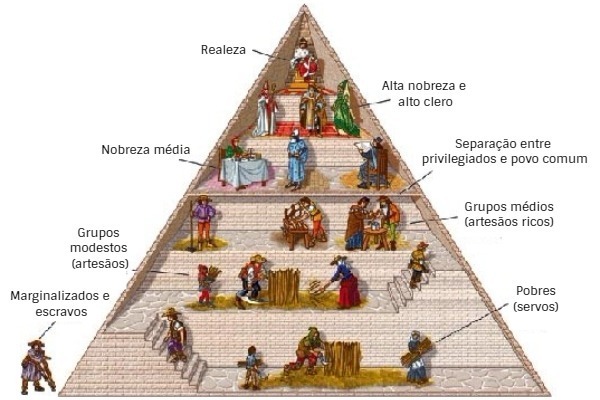Feudalism was a mode of social, political and cultural organization easement-based, where the rural worker was the servant of the great landowner, the feudal lord. Feudalism prevailed in Europe throughout the Middle Ages (between the 5th and 15th centuries).
Feudalism was a system that ruled within the manor, a large rural property, which housed a fortified castle, villages, farmland, pastures and woods.
Characteristics of Feudalism
- Agricultural economics;
- Servitude (vassalage);
- There was no possibility of social mobility;
- Presence of three main social strata: nobility, clergy (the Church) and servants;
- Relation of vassalage and suzerainty;
- Legal, political and economic power concentrated in feudal lords;
- Serfs were required to pay taxes and tribute to feudal lords;
- Strong influence of religious concepts (Catholic Church);
- Wars to obtain new lands were common among feudal lords.
Learn more about Vassals and about the characteristics of feudalism.
Feudalism in the Middle Ages
Feudalism was an economic, social and political system that was very popular in the Middle Ages, more specifically in Western Europe, between the 11th and 15th centuries.
Feudalism reached its peak in Europe in the 11th and 13th centuries, and later, from the 14th century onwards, its characteristics began to undergo some changes. The peasant's bond of servitude to his feudal lord began to disappear, along with the feudal legal institutions.
What was society like in feudalism?
Feudal society was divided into three main classes: the nobility, the clergy and the serfs. The hypothesis of social mobility was practically non-existent in feudalism, that is, serfs were "condemned" to spend the rest of their lives as vassals.

Feudal pyramid shows the hierarchy of society during feudalism.
Nobility
Integrating the nobility were the feudal lords who were responsible for administering the entire manor. They had the power to enforce laws, collect taxes, administer local justice, declare wars between the fiefs, etc.
Clergy
The clergy was formed by the Catholic Church and represented the most important and powerful part of the feudal regime. Its main mission was to ensure the spiritual balance of the manor. Unlike vassals, members of the clergy were free to pay taxes.
servants
It consisted of the majority of the people, that is, the peasants who worked in the fiefs to guarantee the subsistence of the locals. They were required to pay numerous taxes and duties.
How did the feudal economy work?
Commercial activities were practically non-existent during feudalism, being the subsistence and self-sufficient agriculture the main economic source of the fiefs. Monetary exchange (money) did not exist.
O barter (exchange of goods) was also adopted between different fiefs, so that they could obtain products they needed but had not produced, for example.
The serfs exchanged their labor for a place to live on the property of the feudal lord, who was supposed to guarantee the protection of these people. The vassals also produced their own food.
How was politics during feudalism?
All politics were centralized in the hands of feudal lords. The kings granted him many privileges and it was they who had the last word to give within their respective fiefs.
life in manors
Each manor consisted of a production unit of the feudal system, where the serf planted, harvested, made wine, oil, flour, bread, raised cattle, made cheese, butter, hunted, fished and worked in a rudimentary industry handmade.
In the manor, only what was necessary for community consumption was produced, where servile work involved a series of obligations, including:
- serfs worked as tenants, paying the master with goods or services for the use of the land;
- each family worked free for a few days on the lord's land;
- each servant paid fees for the use of the mill, the furnace, and so on.
Feudal lords were responsible for forming private armies and building castles. fortified, where in and around which the feudal community developed, protected by they.
Learn more about the meaning of manors.
Origin of feudalism
Feudalism began to form in the 5th century, with the decay of the Roman Empire and the invasions of barbarian peoples, forcing the Roman nobles to move away from the cities, taking the peasants with them.
The process of feudalization of the economy and the society took several centuries to complete. The presence and violence of invaders and social insecurity led to the isolation of feuds in different regions.
As the kings did not have the economic and military conditions to protect the populations in these areas, the responsibility passed to the large landowners.
In exchange for protection, the vast majority of the population, who came to live in villages around the castles, were subjected to agricultural work, in a relationship of servitude with the owner of the land and the castle.
Crisis of Feudalism
Gradually, the feudal system began to decline, mainly due to some changes in the structure of society, such as the increase in cities it's the revival of business relationships.
With the creation of salaried jobs, a new class emerged in society: the bourgeoisie. With it, a new regime that would become known as capitalism began to develop.
Learn more about Capitalism.

